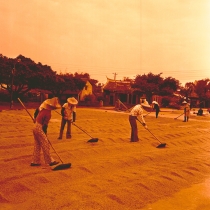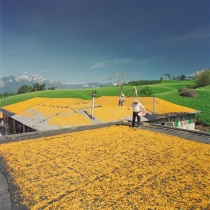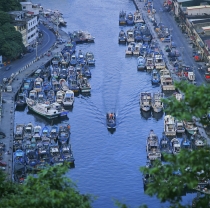|
Tags: agriculture | development | fishing
|
 People are drying unhusked rice under the sun on roads and basketball courts in their village.
People are drying unhusked rice under the sun on roads and basketball courts in their village.
Photo by: GIO Photographer (1976-11-22)
|
 Farmers gather pineapples. The 1970s saw the height of the pineapple industry in Taiwan.
Farmers gather pineapples. The 1970s saw the height of the pineapple industry in Taiwan.
Photo by: GIO Photographer
|
 Women are picking tea in the spring in northern Taiwan’s Mujha.
Women are picking tea in the spring in northern Taiwan’s Mujha.
Photo by: GIO Photographer (1991-04-19)
|
|
 Farmers in Hualien are busy drying edible day lilies in the sun after harvest.
Farmers in Hualien are busy drying edible day lilies in the sun after harvest.
Photo by: GIO Photographer
|
 At Budai Fishing Port, squid are placed on the ground for drying.
At Budai Fishing Port, squid are placed on the ground for drying.
Photo by: GIO Photographer
|
 The busy fishing port of Nanfang’ao is major base of operations for Taiwan’s deep-sea fishing fleet.
The busy fishing port of Nanfang’ao is major base of operations for Taiwan’s deep-sea fishing fleet.
Photo by: GIO Photographer
|
Agriculture was long Taiwan's most important traditional industry. Following the end of Japanese rule and Taiwan's coming under the control of the Republic of China, the government implemented an economic strategy of "using agriculture to foster industry and using industry to cultivate agriculture." In line with this policy, Taiwan launched land reforms which involved rent reductions, the sale of public lands, and putting land to the tiller. These policies successfully increased the value of agricultural production and allowed for large amounts of capital, labor, and market input to be diverted to industrial development, laying the foundation for an economic takeoff.
As Taiwan moved toward joining the ranks of developed nations, agriculture gave way to industry in importance. Agricultural growth slowed and eventually reversed.
Today, Taiwan faces cutthroat competition and other challenges in the global market, but this may provide a great opportunity for its agriculture and fishing to climb to new heights. In seeking sustainable development, the government has been promoting "high-quality agriculture, safe agriculture, recreational agriculture, and eco-agriculture" as goals for achieving a sector-wide transformation as well as the vision of upgrading Taiwan's agriculture. To attain these goals, the government has called for the integration of the agricultural and fishing sectors with technology, to include automatic production facilities, systematic production and marketing techniques and higher levels of research in biotechnology. The transition from traditional agriculture and fishing toward tourism must integrate local lifestyles, the environment, and cultural creative resources such that farmers and fishers might enjoy a higher standard of living. In this way, the development gap between urban and rural areas might also be shrunk.
The government also views innovative research and marketing strategies for agriculture and fishing as important as it hopes to upgrade these sectors from the production stage to the knowledge-based stage. The foundations for doing so are to be found in growing higher-quality products, issuing seals of quality, and marketing brand names.
Through the joint effort of the government and the private sector, the production value of fruit, flowers and plants, tea, and aquatic products is very high in Taiwan, and these products are marketed around the world under the brand image "Taiwan Innovalue." To promote agricultural exports and to point out the special characteristics of the nation's high-quality agricultural products, the Council of Agriculture set up the well-known "Taiwan" agricultural brand to highlight certain agricultural and fishing products from Taiwan. These include the moth orchid (Phalaenopsis), oolong tea, Taiwan tilapia, and mangoes. These flagship exports have received approbation in the international community and are the best example of how the transformation of the agricultural and fishing sectors has succeeded.
Taiwan Image - Photo Archive
Text and images are provided by Ministry of Foreign Affairs, Republic of China (TAIWAN)
|

















